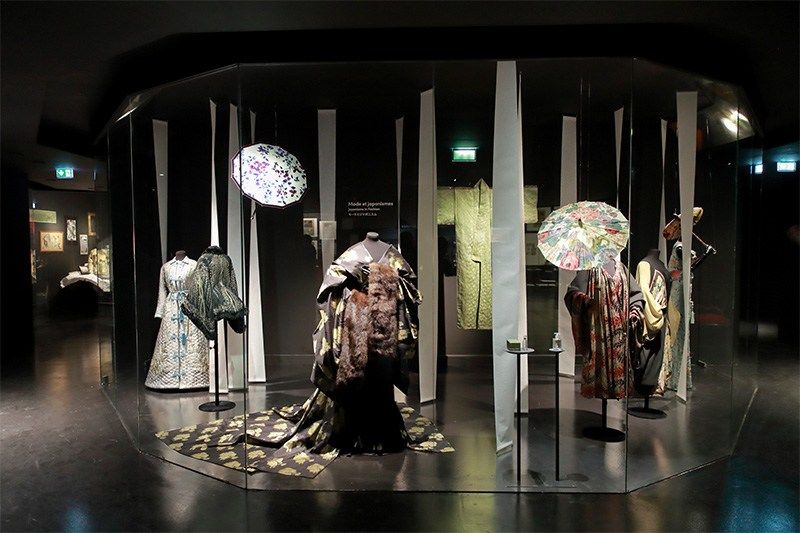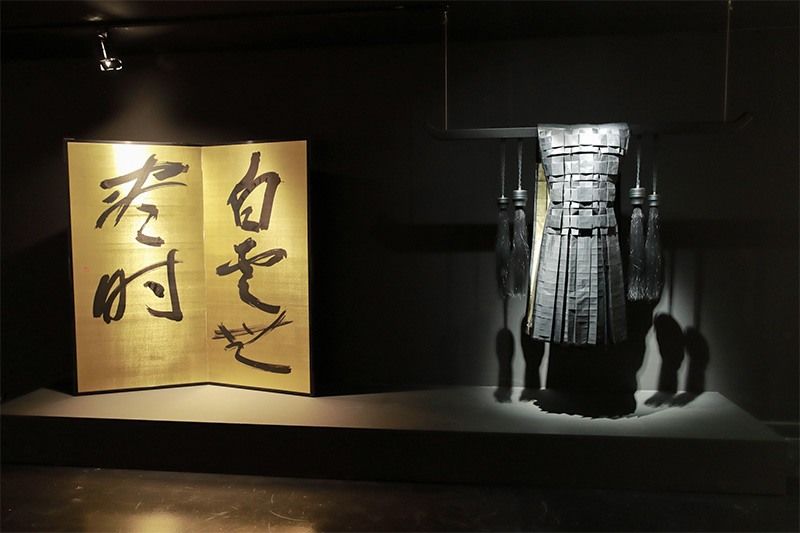
“Cool Traditions” Stay in Tune with Modern Life
Japonism: A Rich History of Artistic Inspiration
Culture- English
- 日本語
- 简体字
- 繁體字
- Français
- Español
- العربية
- Русский
A wide variety of events have been held throughout France from 2018, to commemorate 160 years of diplomatic ties with Japan.

The entrance to the exhibit on Japonism at the Musée des Arts Décoratifs, Paris.
One of the central events in this calendar is the exhibition Japon-Japonismes, 1867–2018, which looks at how Japanese art has been received in France, and the influence it has had on French artists and art history. Founded in 1905, the Musée des Arts Décoratifs has played a leading role in exhibiting the work of artists from Japan. The current exhibition draws on a collection with few parallels anywhere in the world. Although some of the items on display were on loan from Japan, over 90 percent of the exhibits were drawn from the museum’s own unmatched collection.

Béatrice Quette, curator at the Musée des Arts Décoratifs
Encounters Beyond Time and Place
Béatrice Quette, who curated the exhibition, is a specialist on the museum’s Asian collections. She describes the objectives behind the show as follows: “One of the characteristics of our museum is that we not only have a rich and broad collection, but for many years have also functioned as a venue for encounters, a place of exchange between the art of east and west. In this exhibition, we consciously tried to bring about encounters between Japanese and French art, between ancient objects and contemporary art. We deliberately chose to juxtapose objects from different times and places. We wanted to inspire visitors through the relationships, commonalities, and contrasts between them—to give people the freedom to imagine their own narratives. Rather than providing conclusions, we wanted to create an exhibition that would be more open and stimulate the imaginations of the people who came to see it.”

Clothing and umbrellas produced when Japonism was at its height, shown alongside a contemporary collection by John Galliano (center).

Calligraphy by Machi Shunsō (1922–1995) together with armor by a contemporary French artist.

Antique Japanese clothing and calligraphy scrolls are mixed with craft items and an eye-catching pair of pink geta (clogs) in the style that would have been worn by a high-ranking courtesan in the pleasure quarters.
Instead of being organized by period, the displays are arranged into five thematically arranged sections: nature, time, movement, and innovation (which Quette describes as “important elements of Japanese arts”) plus a fifth category arranged from a French perspective: “les acteurs de la découverte,” focusing on the French discovery of Japanese art during the nineteenth century.
The “discoverers” section contains interior decorations and craft arts that once belonged to the passionate collectors who encountered Japanese arts from the second half of the nineteenth century into the twentieth century. This section reveals how the exquisite detail of Japanese art captured the imaginations of French collectors following the pioneering exhibition at the Paris International Exposition of 1867.

The poster on the left is for an exhibition of paintings in 1889 by the artist Louis Dumoulin inspired by his travels in Japan. The motif of the crane is an obvious “borrowing” from Japanese motifs such as those seen on the small plates in the front of this display (thought to be the works of Ogata Kenzan, 1663–1743).
The section devoted to nature displays Japanese works treating scenery and items associated with the four seasons alongside works by French artists who have adapted them. There are striking examples of Japonism works using motifs like sweet flags, chrysanthemums, water lilies, butterflies, and swallows. This section contains a rich range of art deco posters featuring plant motifs, brocaded clothing and umbrellas, and intricately detailed and finely wrought craftworks, offering an enjoyable opportunity to compare the design sensibilities of east and west. In addition to posters from companies like Shiseido and Hanae Mori, the section also includes numerous other materials, including advertising posters from department stores.

This corner brings together works featuring a chrysanthemum theme.

Bamboo motifs feature on clothing, ceramics, crafts, and paintings.
The Shared Pursuit of Beauty
The section on time looks at the important role that time plays in the rhythms of our daily lives, through the seasons, important festivals and other commemorative events, and traditions such as the tea ceremony. This section mostly highlights Japanese arts, including tea ceremony utensils and robes used in ceremonies. It also touches on Japanese religious beliefs, and includes exhibits of Buddhist images and guardian lions found in front of Shinto shrines.

The section on time inspires people in the present by stimulating the imagination with an image of the seasonal events and daily lives of people in olden times.
The “movement” section covers palanquins and other modes of transport, as well as the clothing and masks from cultural practices relating to physical movement, including sumō, theatre, and dance. The exhibition also presents Japanese paintings that skillfully capture these moments of sudden activity and calligraphy imbued with strong flowing movements of the brush, bringing together works that captivated western audiences alongside western works as well. For example a poster of the clown George Foottit wearing thick kabuki-style makeup shows the extent of the influence of Japonism at the time.

The section on movement features nō masks and robes, as well as a nineteenth-century palanquin decorated with foliage work gold-leafed lacquer that once belonged to the Tokugawa family.

This section is inspired by the shows and events that took place in Paris during the Belle Epoque period from the end of the nineteenth century until the outbreak of World War I. On the right is a poster for an appearance by Foottit created by Georges Goursat, known as Sem, one of the most famous cartoonists in France at the time (1863–1934).
Bringing the exhibition to a conclusion is the section on innovations, which places the focus on contemporary arts and crafts and fashion. The fashion section introduces the work of Japanese designers who revolutionized the European world of haute couture with their Japanese eye for beauty and aesthetics, including Yohji Yamamoto, Comme des Garçons, and Issey Miyake. Issey Miyake in particular has created products skillfully combining Japanese aesthetics with cutting-edge technology, including the Nihon Buyō Pleats Please series in collaboration with Tanaka Ikkō and the Bokugi Linen series, a homage to traditional calligraphy and inkwash painting using recycled polyester.

Issey Miyake’s Bokugi Linen series

The Nihon Buyō series (right) uses motifs developed by Tanaka Kōichi (1930–2002) for the Nihon Buyō dance performance at UCLA in 1981.
The section on contemporary arts and crafts introduces the ongoing technological development in the fields of traditional arts like ceramics and lacquerware, and highlights examples of French artists who have adapted these techniques. Also on display are works by Charlotte Perriand, who had close connections with Japan, showcasing the cultural exchanges between Japanese and French artists. In an age of globalization, the unstinting efforts of old family firms with proud traditions of Japanese techniques of craftsmanship to develop new technologies and find new collaborators is a constant source of inspiration.

The chaise longue basculante on the right is a 1940 work by the French architect and designer Charlotte Perriand, who spent more than two years as a member of the mingei folk arts movement in Japan where she became friends with Yanagi Sōri (1915¬-2011) and other Japanese designers.
The exhibition also shows original works created specially by seven French artists, inspired by the curation of the exhibition The Living Treasures of France, held at the Tokyo National Museum in 2017.
Quette sums up the points of commonality shared between Japan and France in this exhibition as follows. “I think there is a common sense of the aesthetics of daily life, and a shared appreciation for the beauty of simple things in art, for example. Probably the Japanese have a more refined and subtle sense for this than the French. The readiness to use new technologies to develop artistic innovations is another part of the reason why so many Western artists continued to be inspired by Japan.”
This latest dialogue between the Japanese aesthetic sensibility and the works of Japonism will surely open the eyes of visitors to new discoveries. The exhibition runs at the Musée des Arts Décoratifs, 107, rue de Rivoli 75001, Paris, until March 3, 2019.
(Originally published in Japanese on December 14, 2018. Interview and text by Satō Kuriko. Photos by Sawada Hiroyuki.)
